|

usgenweb.org |
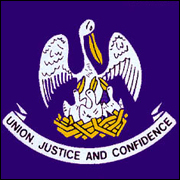
"I
pledge
allegiance
to
the
flag
of
the
state
of
Louisiana
and
to
the
motto
for
which
it
stands:
A
state,
under
God,
united
in
purpose
and
ideals,
confident
that
justice
shall
prevail
for
all
of
those
abiding
here." |

http://www.lagenweb.org/ |
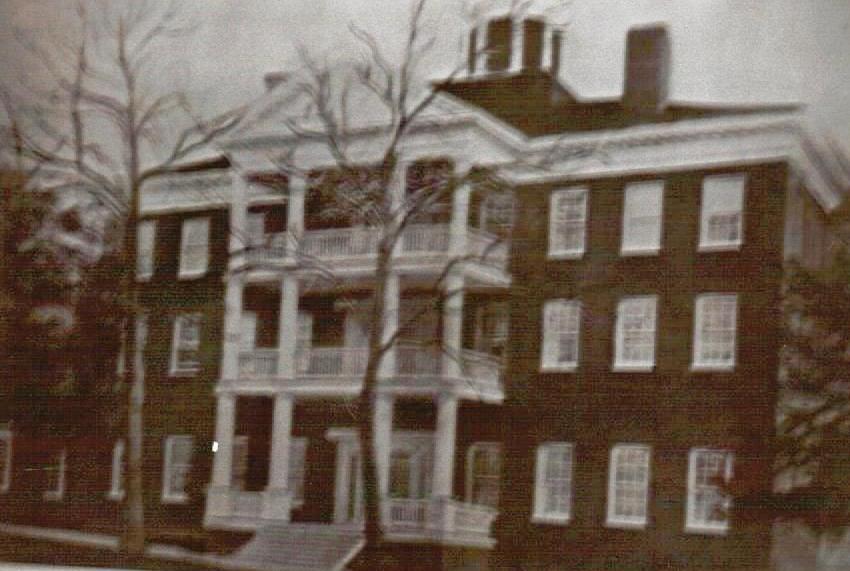
Above picture submitted by
Ora Chrysler
MANSFIELD FEMALE COLLEGE
by Judy Baugh
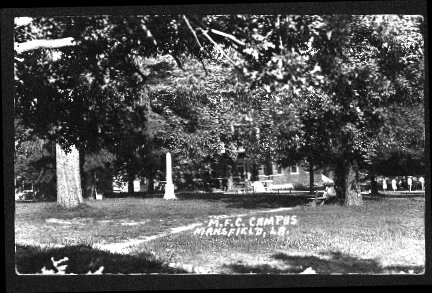 From the early 1850's until 1930 DeSoto Parish was home to Mansfield Female
College, offering primary, academic, secondary, and collegiate education
to girls and young ladies, and a model school for boys of the region. Said
to have been the first school for women established west of the Mississippi
River, MFC's earliest incarnation may have been before 1850. Various sources
credit the idea for the school to different groups or individuals. Whomever,
and regardless of precisely which year, it was a telling reflection of the
rapid population growth of northwest Louisiana in the 50 years after the Louisiana
Purchase.
From the early 1850's until 1930 DeSoto Parish was home to Mansfield Female
College, offering primary, academic, secondary, and collegiate education
to girls and young ladies, and a model school for boys of the region. Said
to have been the first school for women established west of the Mississippi
River, MFC's earliest incarnation may have been before 1850. Various sources
credit the idea for the school to different groups or individuals. Whomever,
and regardless of precisely which year, it was a telling reflection of the
rapid population growth of northwest Louisiana in the 50 years after the Louisiana
Purchase.
The earliest record known to this author of a girls' school
in Mansfield is a tuition statement dated 1852 from the Mansfield Seminary
Co. That was also the year Rev. Henry Coleman Thweatt, a minister in the Louisiana
Conference of the Methodist Church[LCMC] arrived to head the school. In 1854
construction of the three-story, $33,000 main building was begun, and that
year is most often cited as the date the college was founded. In January,
1855 the Board of Trustees* initiated formal transfer of the school to the
Louisiana Conference of the Methodist Church [LCMC]. Two months later it was
legally incorporated as Mansfield Female College. That same year the Louisiana
Legislature appropriated $5000 to assist the building program, persuaded
of the worth of such expenditure by the number of "prolific" male citizens
in DeSoto parish. Another $30,000 had previously been donated/pledged to
the college by various members of that "prolific" male citizenry. On St.
John's Day (June 24) 1856, amid grand ceremony and celebration, the cornerstone
of the main building was placed and filled with items of the time and location
- wine, corn and oil, kid gloves, newspapers, coins, etc. One week later
the school held its first commencement ceremonies.
At the inception of its first official academic year (1855-56), 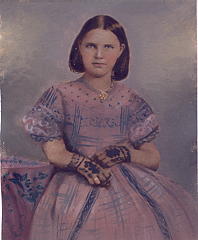 Mansfield Female College was organized into three departments, Primary with
43 students, Academic (secondary) with 22, and a four-year Collegiate Department,
with 30 freshmen, 15 sophomores, 8 juniors, and 4 seniors, of whom three
attained the distinction of being the graduates of MFC's first official class,
they being Misses Virginia Elizabeth Greening [photo at right; later Mrs.
Samuel P. DuBois], Martha J. Pearson [Mrs. Campbell], and Mary E. Stuart
[Mrs. Joseph B. Elam]. Decades later at an alumnae reunion Sarah "Sally"
G. [Moss] Bannerman ('60), a student in the Academic Dept. that first year,
shared her recollections of its year-end festivities - of the processional
of students dressed in white with blue sashes at the laying of the cornerstone,
of singing 'Billy Grimes' in duet with a classmate at the grand concert on
Tues., July 1, and of MFC's gala first commencement on July 2. It was determined
by the President and Trustees that the crowd anticipated for the commencement
ceremony could not be accommodated indoors, so a rustic arbor adorned with
magnolia leaves, bamboo, and native evergreen was constructed in front of the
gallery, which was used as a stage for the afternoon commencement ceremony.
An evening reception, or what Sally Moss Bannerman says was called a "conversation
party", capped the celebratory week.
Mansfield Female College was organized into three departments, Primary with
43 students, Academic (secondary) with 22, and a four-year Collegiate Department,
with 30 freshmen, 15 sophomores, 8 juniors, and 4 seniors, of whom three
attained the distinction of being the graduates of MFC's first official class,
they being Misses Virginia Elizabeth Greening [photo at right; later Mrs.
Samuel P. DuBois], Martha J. Pearson [Mrs. Campbell], and Mary E. Stuart
[Mrs. Joseph B. Elam]. Decades later at an alumnae reunion Sarah "Sally"
G. [Moss] Bannerman ('60), a student in the Academic Dept. that first year,
shared her recollections of its year-end festivities - of the processional
of students dressed in white with blue sashes at the laying of the cornerstone,
of singing 'Billy Grimes' in duet with a classmate at the grand concert on
Tues., July 1, and of MFC's gala first commencement on July 2. It was determined
by the President and Trustees that the crowd anticipated for the commencement
ceremony could not be accommodated indoors, so a rustic arbor adorned with
magnolia leaves, bamboo, and native evergreen was constructed in front of the
gallery, which was used as a stage for the afternoon commencement ceremony.
An evening reception, or what Sally Moss Bannerman says was called a "conversation
party", capped the celebratory week.
The courses of study for the three departments reflect
the trivium of true classical education, augmented by instruction in the
Fine Arts, a curriculum from which the college deviated but little over its
~75 years of existence. The faculty as shown in the 1855-56 catalogue included
Rev. Thweatt, Professor of Moral Science and Ancient Language, his daughter-in-law
Mrs. Caroline Thweatt Assistant Teacher in the Elementary branches, Dr. A. R.
Rembert Professor of Physical Sciences & Mathematics, Miss Lizzie Bates,
A.M. Instructress in English Literature, Modern Languages, Music, Painting,
Drawing and Embroidery, Miss J. F. McCormick M.Ed. Instructress of Music,
Painting, Drawing & Embroidery, Miss Mary E. Crowder M.Ed. Instructress
of the Academic Dept., and Mrs. Elizabeth E. McCormick Instructress in the
Primary Dept. The position of Prof. of Music & Modern Languages was listed,
but no name was associated with it.
Of the 125 students enrolled in 1855-56 (122 departmental
plus 3 pursuing specialized studies who were not assigned to a department),
the vast majority were from DeSoto Parish. Young ladies who lived in the parish,
but well outside of Mansfield, or outside of the parish entirely, appear
to have mostly boarded with local families,. Misses Alabama E. & Dolly
J. Williams ('60), students in the initial Primary and Academic Depts. respectively,
boarded with their aunt and uncle, Patsy & Hilliard Phillips. Mary Cornelia
Wright('60) of Rapides Par. boarded with the family of her classmate Nellie
Burrus. It's clear, however, from the catalogue that MFC offered on-site
boarding, or planned to in the near future. Among the fees listed is "Boarding
- $60 including lights, washing & c.", and one of the regulations set
forth required parents of young ladies boarded with local families to obtain
a guarantee from that family that their daughters would "conform as near
as practicable to the rules and regulations of the Institution".
The rules and regulations regarding the students' schedules,
conduct, etc. cover 6 handwritten pages of the first catalogue. The girls
were to arise at 5 a.m. in the spring and summer, 6 a.m. in the autumn and
winter, and must be in bed by 9 p.m. Due attention must be paid to Physical
Education and exercise. Time must be set aside for studying in the morning
and evening. Novel-reading was emphatically forbidden. Snuff or tobacco in
any form was an "offensive, indecorous, and disgusting" abomination. Visits
from any gentleman other than father, brother, uncle or guardian were expressly
prohibited in the interest of "preventing the exercise of gallantry". Uniforms
were mandatory, in school, on the Sabbath, and all other public occasions.
"The experiences of the past in regard to Female Institutions in this country
evince the great importance of establishing a permanent uniform." Dress rules
which went into effect at MFC Oct., 1856 dictated green worsted for winter,
period. Summer brought more options, dresses in pink calico, gingham or muslin,
one white muslin dress, one brown linen dress. Aprons had to be of brown
linen or barred muslin. Collars had to be plain, white, edged with black.
Bonnets were to be of straw with green lining in winter or pink in summer.
Ribbons must be plain and of solid color. No jewelry was permitted.
Through lively narrative in the diary of the aforementioned
Mary Cornelia Wright unique insight is offered into the experiences of being
a student at MFC during its earliest years, as well as into practical application
of the college's rules and regulations at the end of what turned out to be
a tumultuous second year for the college. The daughter of a Rapides Par.
planter, Mary attended Mansfield Female College only one year. Prior to that
she had been enrolled in a Connecticut boarding school. The following excerpts
from her diary are unedited for spelling and grammar.
(April 5th[1857]) ".....Every body about here
has a mania for these great hoops. The papers report them out of fashion
elsewhere. I think it time after all the scandalous stories written and ugly
caricatures. Nellie [ed. note: Mary's classmate and daughter of the family
with whom she boarded] has just made her one, but she has it a little too
large, and she won't wear it much because the girls laugh at it, I suppose.
Eugenia calls it a 'rag-cage' (a very appropriate & original remark)
and the girls have heard about it and so that is its name."
(undated, written between April 7th & May 21st)"...I have not
recited a lesson today, because the teachers were with the trustees consulting
about another little fuss in school. The faculty and trustees have been deeply
occupied with it for the last week. Five or six of the girls have been brought
before the trustees. Last Friday these girls happened to meet together in
one of the rooms in the college. Some were excused to go home; some were
practicing, and others putting away music. They stopped on the way and went
into a room where Clara Jewel was practicing and asked her to play a piece
to dance by. Some gentlemen were in the vicinity at the time, and some of
the girls knew it. Mrs. Mitchel was passing at the moment and reported them,
and that was all. And all this serious discussing over a few thoughtless
girls! Eliza Crosby was condemned because she danced a polka instead of going
directly home; Clara was brought before the band [sic] of trustees
this morning because she changed her practicing piece for a polka at the
request of the girls; Kate Paul and Rosa Nickleson were heathenish enough
to indulge in a Polka and Delia Rogers and Laura Crosby were sinful enough
to look at them. But the greatest crime was that all this happened just when
these young gentlemen took the privilege of looking on. Horridly immodest
in the girls! They have finally arrived at the conclusion not to expell or
suspend the wretched creatures (a sad disappointment to Proff. Pitts) but
let the poor things escape with a reprimand before the school, and a threat
of dismissal if the offense was repeated. I believe Mrs. Jewel will take Clara
away and send her to Nashvill....."
(May 21) . . . Monday someone tried to set the College on fire.
It was discovered at noon by the perfume of burning paper and when Bob went
into the music room attached to the school-room he found a pile of paper
in one corner with some matches, but the fire was nearly out. Then this morning
one of the desks in the school-room was found complely burnt out, but fortunately
the lid of the desk had been closed & the fire was smothered. There was
a heap of splinters there to kindle the fire. Dr. Thweatt does not know who
did it, but asked the girls if they did it. (June 4th) Oh! How time flys!
Only three weeks before that terrible examination before the Faculty and
Trustees! It frightens me to think how unprepared I am for so rigid an examination.
What if I make a failure? Then I shall get no diploma, which diploma I do
not in reality deserve. Mr. Ritts says he will examine us on Descriptive
Geometry two hours if he can have the time. I did not dislike this private
examination at first; but I feel so frightened now. It seems lately that
I am studying for naught; for I do not recollect any I dig & delve over
for hours. It is provoking and discouraging; but it is all my own fault.
I am frightened about our compositions too; for all my class are smarter
than I in composing. I wonder who will get the valedictory. The girl who
acquits herself the most creditably in her reasons, I suppose, I have translated
_____? Lines from the Eanied for my composition which is to be delivered
tomorrow. Dr. Thweatt has been ill for the last week with that everlasting
old gout. I hope he will be in school tomorrow, for we should be reviewing
our French & Latin before now. Besides I like him to occupy the great
armchair in the school-room much better than to have Mr. Ritts. I hope I’ll
get a letter from home tomorrow. (June 9th) So many things have happened since
last week, I do not really know where to commence. The Trustees have dismissed
Mr. & Mrs. Plagge and Mrs. Mitchel has left school to travel with her
sick husband. Mrs. Quarles takes her place for the present, and Mrs. Scales
occupies her & Mrs. Plagge’s position. Dr. Thweatt is well again and in
school as busy as ever. There is so much disturbance in school that I fear
we will stand a poor Examination. This community is so corrupt; a perfect
hot-bed of scandal! Every trivial matter is exaggerated and flies like wild-fire
over the country. I am very much disappointed in Mrs. Plagge. I thought her
a poor, ill-used wife and pitied her accordingly; but thought it very strange
for a wife to expose all her own husband’s faults. I knew he was supremely
selfish, but now I know she was jealous, and a woman of no high principles.
She had the impudance to tell a lady in town that Mr. Plagge had been paying
attention to our Nellie and that Nellie stayed after school to take music
lessons, and that she had heard them talking on different subjects from the
lesson! That lady told Mrs. Burruss & Mrs. & Mr. B. have been very
much distressed, and Nellie was miserable at first, but she does not care
now since Mr. Plagge was dismissed. That news has been distributed over town
in broken doses, & the school girls have it as a little pieces? of scandle
to talk over. Nellie wished she was dead, because she feared her reputation
would be tarnished. Such scandle deserves severe punishment. Some vicious
person has been writing insolent missels to Dr. Thweatt. One was found this
morning & the girls has the baseness to open & read. It was signed
"Ulreca Catis" (on of our little scholars, and also said if Dr. T. would
apply to me I would give all desired information! I expect it be all over
town that I had written a vulgar letter to Dr. T. One of the scholars died
yesterday & we followed her to the grave today. A great many persons
have died lately and the girls are getting alarmed and leaving school in
groups. The school cannot be sustained long at this rate.
(June 16th) Well it is all over and here we are set adrift upon
the Ocean of Life! We were examined privately today--only before the Faculty
and five Trustees. This disease--Flux[ed. note: probably dysentery]
, has become an epidemic and the girls are in a general panic. Dozens of them
have been thas beome cepiaken home, and as the Trustees saw the school was
declining, they decided to have the general examination a month earlier.
We seniors, then had only two days warning to prepare ourselves for a rigid
examination on studies which we had never reviewed! The whole affair was
very unjust. Dr. Thweatt made no oppology for the short time we had to prepare,
and then gave us no chance to display our acquirements. The (two) first)
hours of this morning were taken up in calling the Trustees together. The
poor creatures were so loth to come that Dr. Thweatt was obliged to send
for them twice. I was frightened at first in one? Discriptive Geometry, but
afterwards I did not care. After dismissing us this evening the Faculty &
Trustees remained to decide & vote who should get Deplomas & who
the honors. It was decided, & very unjustly, to give us no Latin Deplomas.
Nellie obtained the valadictory & I the salutatory. The rest of the girls
write common compositions.
Undoubtedly, Dr. Thweatt and the remaining faculty breathed
a deep and thankful sigh of relief at the conclusion of the 1856-57 academic
year. Infractions of the college rules were just 'part of the territory',
as of course was the occasional need to dismiss faculty members. Epidemics
were unfortunate, but not uncommon. The attempts at arson, however, were singular
and unpleasant phenomena. Especially taxing must have been the fact that
so much happened during so brief a time, but as Louise Hewitt would write
a century later "MFC had its tragedies and mysteries, its comedies and romance".
It is a credit to H.C. Thweatt's firm but benevolent
administration that the next few years at Mansfield Female College were,
as far as can be discerned, far less eventful. Only with difficulty could
a better administrator have been found for an incipient institution. In addition
to his apparently superior interpersonal skills, Dr. Thweatt seems to have
possessed a talent for fund-raising that would have warmed the heart of Regents
or Trustees at any school, anywhere, any time. In addition to the finer details
of each event attendant MFC's first commencement, the then 12-year-old Sally
Moss Bannerman would later recall Dr. Thweatt's "call for money that day,
for the purpose of purchasing that old bell, lightning rods, and a chemical
apparatus--the Laboratory was already projected. Dr. Thweatt knew when and
where to make that important call, and the good people under that rustic arbor
responded liberally and with alacrity--the bell and lightning rods were paid
for and $1,700 subscribed for the apparatus". On Feb. 28, 1857 Mary Cornelia
Wright noted in her diary that ". . . We are to have regular concerts, and
pay for the College pianos with the money so received. . . .".
It is unclear when Dr. Thweatt's tenure as President
of MFC ended and Charles Stuart's begain. Three months after the abrupt termination
of the 1856-57 academic year, Dr. Thweatt wrote in postscript to A.G. Jordan
of Pleasant Hill that "The college here is nearly completed....". It seems
reasonable to presume that the Louisiana Methodist Conference would soon have
desired the presence of so able a man at any among a number of other incipient
institutions under its wing, but anecdotal evidence suggests Dr. Thweatt
was in Manfield through the close of the 1862-63 year. His memories of the
old school must have been fond ones, for on his instructions he was buried
on the campus after his death in 1881, "where the children can crack hickory
nuts on my tombstone".
Enrollment increased and the college continued to prosper
through the end of the 1860-61 school year. Once the war began enrollment
diminished somewhat, but the college remained open during first two years,
graduating classes in 1862 and 1863. The young ladies did their part for the
Confederate cause, raising $95 to send to aid sick and wounded Louisiana soldiers
in Kentucky with a presentation of Tableaux Vivants, followed by vocal and
instrumental music in Dec., 1861. That the school didn't re-open in the fall
of 1863 was more likely due to the economic strain of the war and a prolonged
regional drought than to the advancing federal army. With less tuition coming
in, and subscribers unable to meet their pledges, the college could not satisfy
$10,000 remaining construction debt, and was forced to auction off its land,
buildings and furnishings. The buildings, as well as most every other structure
in the parish, were pressed into service as a hospital before, during, and
after the battles at Mansfield & Pleasant Hill, April 1864.
Thirteen local planters subsequently pooled cash and
cotton to buy back the school for $2000 Confederate money. The LCMC agreed
to resume its stewardship, and the school reopened in fall, 1865 under the
presidency of Charles B. Stuart. Enrollment was 50 students. The 1867-68 college
catalogue reflects a slight increase in enrollment to 64, of whom 21 boarded
at the school, and also offers the first documentation in possession of this
writer of the Model School for boys. In the back of the catalogue is a page
advertising the "Male School, Classical and Mathematical, Mansfield, La.
The Seventh Session of this school will commence on MONDAY the 7th day of
September, 1868......John W. Stuart, Principal". Classes at that time were
held in a building at the northwest corner of Franklin and Madison. The boy's
school would eventually count among its alumni Louisiana Supreme Court Justice
Frank Hawthorne and theatrical producer Josh Logan.
Although it would be the dawn of the 20th century before
the college's enrollment approached its antebellum strength, the MFC maintained
a steady following and consistently operated on sound economic footing. The
curriculum changed but little, conduct remained carefully regulated, and
uniforms were still the order of the day - but fees did increase somewhat.
By 1882 the boarding fee had increased to $150, and tuition had increased
commensurately from the $25 per session for students in the Collegiate Dept.,
1855. In 1881, Kate DuBois, daughter of Virginia Elizabeth [Greening] DuBois('56)
had become the first second-generation MFC graduate. As such she stood at
the forefront of what would become an extraordinary number of legacied graduates
following in the footsteps of mothers, aunts, grandmothers, and great-grandmothers.
Over the next six years Kate's four younger sisters would not only follow
suit, but would enter brief careers as teachers before marrying. This was
not unheard of in graduates of their mother's generation, some of whom came
back to teach at their alma mater, but after the war and reconstruction it
was much less exceptional.
The only major disruption to life at MFC after the war
occurred June 16, 1883 when then President J. Lane Borden was murdered by
a member of a prominent Mansfield family who believed that Borden had seduced
his affianced, a student at MFC. The killing was heavily reported, and with
no shortage of bias, in denominational publications. Borden was, of course,
a Methodist. The man who killed him was of another major Protestant denomination.
The accounts in the denominational publications favored their respective affiliate.
Only from extant city newspapers is it possible to find a somewhat objective
account of the facts. Borden was shot once inside a store in downtown Mansfield.
He ran outside, pursued by his killer who shot several more times, hitting
Borden twice more. He died two hours later. Satisfied at having exacted his
measure of revenge, the man who shot him did not flee, but surrendered to
local law enforcement. He was tried, convicted, and had served less than
three years in prison when pardoned by Gov. McEnery, Jan., 1886 "because
the prison air did not agree with him".
Excepting the two years MFC was closed during the war,
1895-96 was the only year the college had no graduates. Perhaps not coincidentally,
it was also the first year of public high school in Mansfield - and the first
Assistant Principal of Mansfield Central High School was an MFC graduate,
Miss Annie DuBois ('83). The void of graduates at MFC that year is somewhat
misleading, however, as the late 19th century was a time of expansion for
the college. New classrooms and dormitories were added, and they would be
needed to accomodate the increase in enrollment that would take place in
the next century.
Changes in accreditation requirements for institutions
of higher education in Louisiana resulted in MFC's formal accreditation as
a junior college early in the 20th century. Sources differ as to precisely
when MFC officially became a two-year instead of a four-year college, but
records indicate the last 4 year degrees were conferred in 1912. Thereafter,
the vast majority of graduates are recorded as having received "L.I." degrees.
At that time, the two year course leading to the Licentiate Instructor degree
qualified the recipient for lifetime certification to teach in elementary
or grade schools in Louisiana (and many other states).
These regulatory constructs changed day-to-day life at
MFC little if at all. By then educating no small number of third generation
students, the college held fast to the long established standards and traditions
that had well served the mothers and grandmothers of current students, and
which made the school a source of great pride to the region. A comparison
of the first and last catalogues of the school reveals more descriptive detail,
but few changes in the core curriculum from that of 1855. It began, and was
always, a solid classical education. From alumnae reminiscences may be discerned
an equally solid esprit-de-corps born of shared experiences at the old school
- the rigors of oral examinations, the week-long celebrations attendant the
annual commencement exercises (which by the 1920's had become a regional
event complete with college queen and her court), the legend of Peg-Leg (a
ghost said to have haunted the main building since it was used as a hospital),
the annual gathering at the battlefield - and many more. Mary Cornelia Wright,
who was shocked by her classmates' spur of the moment polka, might simply
have perished had she witnessed some spirited young ladies slipping off to
swim in their underwear during the annual battlefield picnic some 50+ years
later. (They were caught by the Dean, who apparently exercised the same firm
but benevolent discipline as had Dr. Thweatt.)
Ironically, MFC's enrollment peak was within a few years
of its closing. Several times during its last decade the school exceeded 200
students, and graduates usually numbered between 30-40. There was a slight
decline subsequently, but one that probably could have been weathered had
it not been for the Great Depression. Finding the school on shaky financial
ground again, the Methodist Conference reluctantly decided not to re-open
the school after the end of the 1929-30 year. Again, there was an attempt
by generous patrons to save the school, but this time it wasn't enough, and
for the parish, faculty, students and alumnae, the curtain fell on an educational
era. The colleges' buildings and grounds were sold to State Sen. Reimer Calhoun,
whose family has now so generously donated the old main building to the state
of Louisiana, in recognition of its historic significance.
Long after it closed, the spirit of MFC lived on through
its alumnae. The last of their reunions, at least to this writer's knowledge,
took place in 1980, honoring the 50th anniversary of the colleges' last graduating
class. No doubt they would all have agreed with the spirit of the verses
quoted by Sally Moss Bannerman at a reunion long 'ere that one-
Backward turn backward, O' time in thy flight. Make me a girl again just
for tonight
*Dr. Robert T. Gibbs was the first president of the Seminary's Board
of Trustees, which included Jacob D. Wemple, William Crosby, Col. Richard
T. Johnson, Rev. W.W. Bell, Col. Hamilton Sloan, Sam H. Rives MD, J.D. Wilder
MD, Alex M. Cambell, Gen. Henry Phillips, John Jordan, Jesse M. Williams,
Daniel Brown, Henry Moss, Col. R. H. Caruth, Rev. William E. Doty, Lewis Phillips,
Jones Persons, William H. Terrel, George C. Burns, Maj. Joseph Harper, Benjamin
W. Pearson, J. H. Mumford MD, George R. Draughon, and Rev. John Burrus(3).
1867-1868 Rev. William E. Doty of Caddo Par., President, Rev. John Pipes
of Mansfield, Rev. Benjamin F. Alexander of Pleasant Hill, Maj. John J. Greening
of Mansfield, and John Holmes Esqr., of DeSoto Parish.
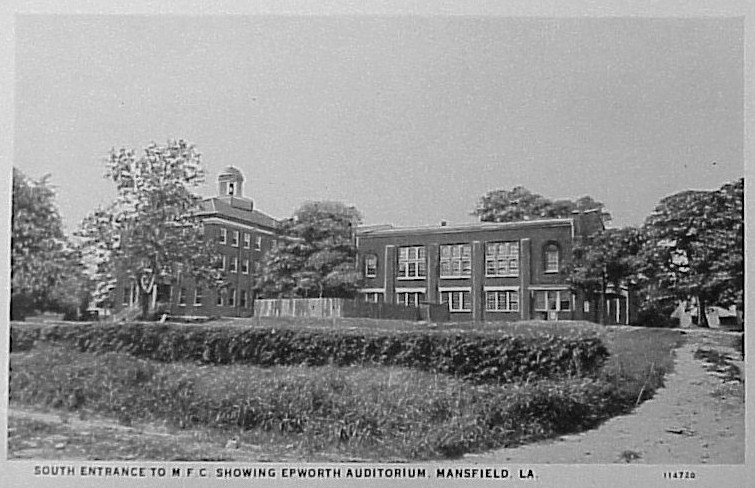
Reminiscences of Mansfield Female College First
Commencement
Graduates 1856-1895
Graduates 1897-1930
All Students 1855-56
DO
YOU RECOGNIZE THESE MFC GRADS?
Photo courtesy of Linda Trichel
THE MANSFIELD FEMALE COLLEGE MUSEUM
101 Monroe St., Mansfield
In 2002 the Huckaby and Calhoun families donated the MFC property and grounds to the State of Louisiana.
It was added to the Secretary of State's Museum Programs during the 2003
legislative session
and is now open Mon. - Fri. 10 a.m. - 5 p.m., admission free.
Join Friends of the MFC Museum
Back to DeSoto
Main Page
|
Copyright © 1997-present by
Jane Keppler
This
information may be used by individuals for their own personal
use, libraries and genealogical societies. Commercial use of
this information is strictly prohibited without prior written
permission
from
Jane Keppler.
If material is copied, this copyright notice must appear with
the information and please email me and let me know.
Neither the Site Coordinators nor
the volunteers assume any responsibility for the information or
material given by the contributors or for errors of fact or
judgment in material that is published at this website. |
|
Page
Modified:
11 September 2024

|
|
DeSoto is part of the
LAGenWeb
Project, State Coordinator:Marsha Holley
|
|
Copyright © 1997-2009 by
Jane Keppler
This
information may be used by individuals for their own personal
use, libraries and genealogical societies. Commercial use of
this information is strictly prohibited without prior written
permission
from
Jane Keppler.
If material is copied, this copyright notice must appear with
the information and please email me and let me know.
Neither the Site Coordinators nor
the volunteers assume any responsibility for the information or
material given by the contributors or for errors of fact or
judgment in material that is published at this website. |
|
Page
Modified:
11 September 2024
|
|
DeSoto is part of the
LAGenWeb
Project, State Coordinator:Marsha Holley
|




 From the early 1850's until 1930 DeSoto Parish was home to Mansfield Female
College, offering primary, academic, secondary, and collegiate education
to girls and young ladies, and a model school for boys of the region. Said
to have been the first school for women established west of the Mississippi
River, MFC's earliest incarnation may have been before 1850. Various sources
credit the idea for the school to different groups or individuals. Whomever,
and regardless of precisely which year, it was a telling reflection of the
rapid population growth of northwest Louisiana in the 50 years after the Louisiana
Purchase.
From the early 1850's until 1930 DeSoto Parish was home to Mansfield Female
College, offering primary, academic, secondary, and collegiate education
to girls and young ladies, and a model school for boys of the region. Said
to have been the first school for women established west of the Mississippi
River, MFC's earliest incarnation may have been before 1850. Various sources
credit the idea for the school to different groups or individuals. Whomever,
and regardless of precisely which year, it was a telling reflection of the
rapid population growth of northwest Louisiana in the 50 years after the Louisiana
Purchase.  Mansfield Female College was organized into three departments, Primary with
43 students, Academic (secondary) with 22, and a four-year Collegiate Department,
with 30 freshmen, 15 sophomores, 8 juniors, and 4 seniors, of whom three
attained the distinction of being the graduates of MFC's first official class,
they being Misses Virginia Elizabeth Greening [photo at right; later Mrs.
Samuel P. DuBois], Martha J. Pearson [Mrs. Campbell], and Mary E. Stuart
[Mrs. Joseph B. Elam]. Decades later at an alumnae reunion Sarah "Sally"
G. [Moss] Bannerman ('60), a student in the Academic Dept. that first year,
shared her recollections of its year-end festivities - of the processional
of students dressed in white with blue sashes at the laying of the cornerstone,
of singing 'Billy Grimes' in duet with a classmate at the grand concert on
Tues., July 1, and of MFC's gala first commencement on July 2. It was determined
by the President and Trustees that the crowd anticipated for the commencement
ceremony could not be accommodated indoors, so a rustic arbor adorned with
magnolia leaves, bamboo, and native evergreen was constructed in front of the
gallery, which was used as a stage for the afternoon commencement ceremony.
An evening reception, or what Sally Moss Bannerman says was called a "conversation
party", capped the celebratory week.
Mansfield Female College was organized into three departments, Primary with
43 students, Academic (secondary) with 22, and a four-year Collegiate Department,
with 30 freshmen, 15 sophomores, 8 juniors, and 4 seniors, of whom three
attained the distinction of being the graduates of MFC's first official class,
they being Misses Virginia Elizabeth Greening [photo at right; later Mrs.
Samuel P. DuBois], Martha J. Pearson [Mrs. Campbell], and Mary E. Stuart
[Mrs. Joseph B. Elam]. Decades later at an alumnae reunion Sarah "Sally"
G. [Moss] Bannerman ('60), a student in the Academic Dept. that first year,
shared her recollections of its year-end festivities - of the processional
of students dressed in white with blue sashes at the laying of the cornerstone,
of singing 'Billy Grimes' in duet with a classmate at the grand concert on
Tues., July 1, and of MFC's gala first commencement on July 2. It was determined
by the President and Trustees that the crowd anticipated for the commencement
ceremony could not be accommodated indoors, so a rustic arbor adorned with
magnolia leaves, bamboo, and native evergreen was constructed in front of the
gallery, which was used as a stage for the afternoon commencement ceremony.
An evening reception, or what Sally Moss Bannerman says was called a "conversation
party", capped the celebratory week. 